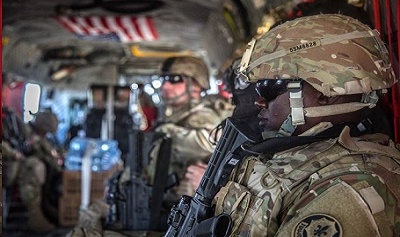U.S. Military Strikes Continue in Somalia, Syria and Iraq: Dana White
U.S. forces conducted a strike operation against al-Shabab in Somalia Sunday, approximately 185 miles southwest of Mogadishu, according to a statement issued by chief Pentagon spokesperson Dana W. White.
The United States conducted this operation in coordination with its regional partners as a direct response to al-Shabab actions, including recent attacks on Somali forces, the Pentagon spokesperson said.

This strike was conducted with the authorities approved by the president in March, which allows the Defense Department to conduct legal action against al-Shabab within a geographically-defined area of active hostilities in support of partner forces in Somalia, White said in the statement.
“We remain committed to working with our Somali partners and allies to systematically dismantle al-Shabab, and help achieve stability and security throughout the region,” White said.
U.S. and coalition military forces continued to attack the Islamic State of Iraq and Syria yesterday, conducting 34 strikes consisting of 70 engagements, Combined Joint Task Force Operation Inherent Resolve officials reported today.
Officials reported details of yesterday’s strikes, noting that assessments of results are based on initial reports.
Strikes in Syria
In Syria, coalition military forces conducted 27 strikes consisting of 35 engagements against ISIS targets:
— Near Abu Kamal, two strikes destroyed three ISIS oil storage tanks.
— Near Dayr Az Zawr, eight strikes destroyed 23 ISIS oil tanks, three ISIS separation tanks, two ISIS well heads, an ISIS-held building and an ISIS refinery.
— Near Raqqah, 17 strikes engaged 15 ISIS tactical units and destroyed six fighting positions, four vehicles, two ISIS front-end loaders, two ISIS headquarters, an ISIS unmanned aerial vehicle and an ISIS barge.
In Iraq, coalition military forces conducted seven strikes consisting of 35 engagements against ISIS targets:
— Near Bayji, two strikes engaged two ISIS tactical units and destroyed three vehicles, two tactical vehicles, two ISIS-held buildings, an anti-air artillery system and an ISIS staging area.
— Near Kisik, a strike engaged two ISIS tactical units and destroyed six fighting positions, four car bombs, two mortar systems, a medium machine gun, and an ISIS staging area.
— Near Mosul, three strikes engaged two ISIS tactical units; destroyed five fighting positions, two mortar systems, two car bombs, a supply cache, and an explosives cache; and suppressed a mortar team.
— Near Tal Afar, a strike engaged an ISIS tactical unit and destroyed a vehicle.
Previously Unreported
Additionally, 11 previously unreported strikes were conducted in Syria and Iraq on June 8-9.
— On June 8, near Raqqah, Syria, a strike engaged an ISIS tactical unit.
— On June 9, near Raqqah, Syria, nine strikes engaged three ISIS tactical units and destroyed four fighting positions, two car bombs, two weapons caches, and an ISIS staging area.
— On June 9, near Mosul, Iraq, a strike engaged an ISIS tactical unit; destroyed an artillery system, an ISIS staging area, a fighting position, and a tunnel; and damaged two ISIS supply routes.
Part of Operation Inherent Resolve
These strikes were conducted as part of Operation Inherent Resolve, the operation to destroy ISIS in Iraq and Syria. The destruction of ISIS targets in Iraq and Syria also further limits the group’s ability to project terror and conduct external operations throughout the region and the rest of the world, task force officials said.
The list above contains all strikes conducted by fighter, attack, bomber, rotary-wing or remotely piloted aircraft; rocket-propelled artillery; and some ground-based tactical artillery when fired on planned targets, officials noted.
 Ground-based artillery fired in counterfire or in fire support to maneuver roles is not classified as a strike, they added. A strike, as defined by the coalition, refers to one or more kinetic engagements that occur in roughly the same geographic location to produce a single or cumulative effect.
Ground-based artillery fired in counterfire or in fire support to maneuver roles is not classified as a strike, they added. A strike, as defined by the coalition, refers to one or more kinetic engagements that occur in roughly the same geographic location to produce a single or cumulative effect.
For example, task force officials explained, a single aircraft delivering a single weapon against a lone ISIS vehicle is one strike, but so is multiple aircraft delivering dozens of weapons against a group of ISIS-held buildings and weapon systems in a compound, having the cumulative effect of making that facility harder or impossible to use. Strike assessments are based on initial reports and may be refined, officials said.
The task force does not report the number or type of aircraft employed in a strike, the number of munitions dropped in each strike, or the number of individual munition impact points against a target.



